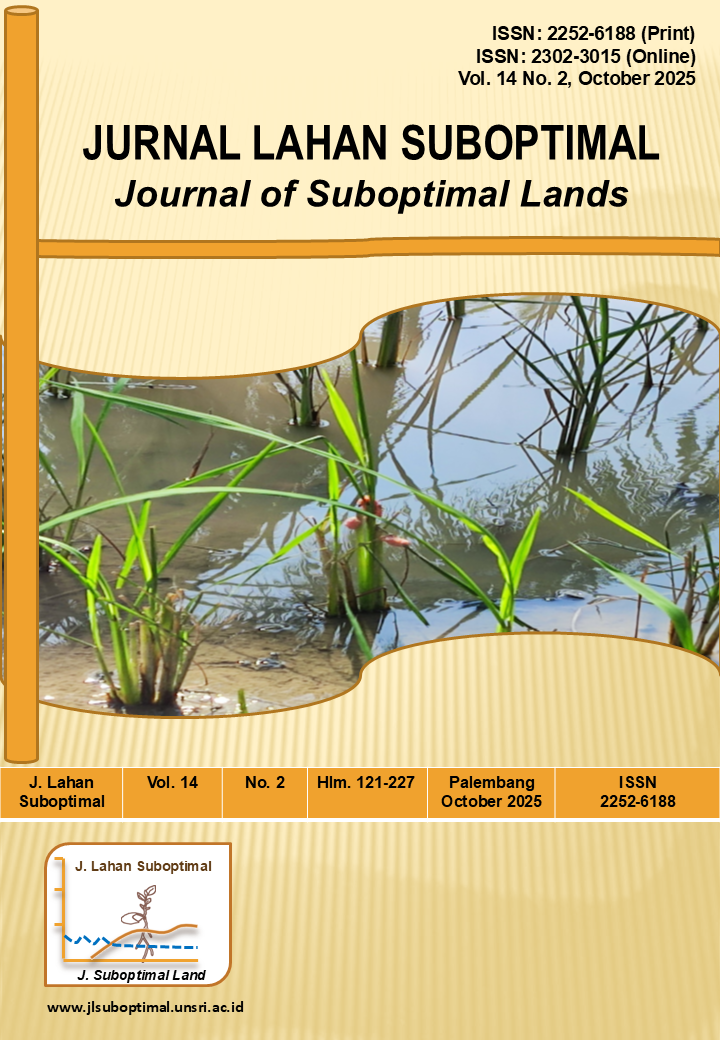The growth and yield of Capsicum annuum L. variety Gada F1 on NPK 16:16:16 fertilizer
DOI:
https://doi.org/10.36706/jlso.14.2.2025.692Keywords:
fertilizer dose, gada F1, NPK fertilizer, plant growth, red chiliAbstract
Red chili was one of the most strategic vegetable commodities because the market demand was high every day. Efforts to increase chili productivity were needed so that chili prices were stable and market demand was met. The research aimed to determine the growth and yield of the red chili Gada F1 variety against NPK 16:16:16 fertilizer. This research uses the Randomized Block Design (RBD) method, consisting of 4 treatment levels and 3 replications. P0 = control, P1 = NPK fertilizer 2.5 g/polybag, P2 = NPK fertilizer 5 g/polybag, and P3 = NPK fertilizer 7.5 g/polybag. The application of NPK 16:16:16 fertilizer to the growing medium significantly influenced several growth and yield parameters, including the number of leaves, crown diameter, leaf greenness, fruit weight, number of fruits, fruit length, and fruit diameter. In contrast, it had no statistically significant effect on plant height, flowering time, number of branches, root fresh weight, crown fresh weight, root dry weight, or crown dry weight. Among the treatments, the application rate of 7.5 g/polybag (P3) yielded the most favorable results across the majority of measured parameters. Accordingly, an NPK 16:16:16 dosage of 7.5 g/polybag was recommended for the cultivation of the red chili (Capsicum annuum L.) variety Gada F1.
References
Amanda, A. P., Mulyana, M. A., & Wahyuningtyas, A. (2023). Effect of NPK dose (16:16:16) on growth and yield of cayenne chili (Capsicum frutescens L.) in Tasikmalaya. Jurnal Biologi Tropis, 23(4), 233–237. https://doi.org/10.29303/jbt.v23i4.5561
Amartiya, S. S., & Gofar, N. (2023). Percentage of flower and fruit fall, and red chili production in ultisol applied biostimulants and inorganic fertilizers. Jurnal Lahan Suboptimal : Journal of Suboptimal Lands, 12(2), 184–194. https://doi.org/10.36706/jlso.12.2.2023.639
Arthanawa, I. G. N., Astika, I. N., Darmawan, I. K., Yana, D. P. S., Situmeang, Y. P., & n Sudita, I. D. N. (2022). The effects of organic and inorganic fertilizers on red chili plants. SEAS (Sustainable Environment Agricultural Science), 6(1), 70–80. https://doi.org/10.22225/seas.6.1.5104.70-80
Castillo-Téllez, M., Pilatowsky-Figueroa, I., López-Vidaña, E. C., Sarracino-Martínez, O., & Hernández-Galvez, G. (2017). Dehydration of the red chilli (Capsicum annuum L., costeño) using an indirect-type forced convection solar dryer. Applied Thermal Engineering, 114, 1137–1144.
Cendana, U. N., Sumiyati, S., Cendana, U. N., Lion, T., Cendana, U. N., Nubatonis, R., Cendana, U. N., & Dose, C. M. (2021). The effect of chicken and cow manure dose combination on the growth and production of red chili (Capsicum annum L.). Journal of Biological Science and Education, 3(2), 53–58. https://doi.org/10.31327/jbse.v3i2.1574dc
Constantia, J., & Ferniah, R. S. (2020). Vegetative growth of rainbow chili (Capsicum annuum L.) in the treatment of PGPR (Plant Growth Promoting Rhizobacteria), PGPR-NPK fertilizer, and pgpr-compost combination. Journal of Agricultural Science (Agric), 32(2), 95–104. https://doi.org/10.24246/agric.2020.v32.i2.p95-104
Dias, S. A. C., Fonseca, J. G., & Ramadhan, D. (2023). The effect of vermicompost fertilizer and mutiara NPK 16:16:16 on the Growth and production of pakcoy plant (Brassica Rapa L.). Journal of Geoscience, Engineering, Environment, and Technology, 8(2), 148–157. https://doi.org/10.25299/jgeet.2023.8.2.14493
Dubey, A. K., Singh, D., Rajput, P. S., Kumar, Y., Verma, A. K., & Chandraker, S. K. (2017). Effect of NPK on plant growth, yield and quality of capsicum (Capsicum annum L.) C.V. Swarna Under Shade Net Condition. International Journal of Current Microbiology and Applied Sciences, 6(3), 1085–1091. https://doi.org/10.20546/ijcmas.2017.603.125
Ferniah, R. S., Pujiyanto, S., & Kusumaningrum, H. P. (2018). Indonesian red chilli (Capsicum annuum L.) capsaicin and its correlation with their responses to pathogenic Fusarium oxysporum. NICHE Journal of Tropical Biology, 1(2), 7–12. https://doi.org/10.14710/niche.1.2.7-12
Fidiyawati, E., Setyorini, D., Sa’Adah, S. Z., Prayitno, A., & Istiqomah, N. (2021). The effect of the consentration of macro-nutrient-liquid-foliar- NPK and dosage of NPK 15-5-15 fertilizer to improve the quality of red chilies (Capsicum annum L.). IOP Conference Series: Earth and Environmental Science, 759(1),1‒2. https://doi.org/10.1088/1755-1315/759/1/012039
Gofar, N., Nur, T. P., Amartiya, S., Haryono, A., Pujiati, & Utami, H. A. (2023). Application of liquid organic pusri fertilizer (LOPF) and inorganic fertilizer on ultisols planted with red chili (Capsicum annuum L.). IOP Conference Series: Earth and Environmental Science, 1162(1), 1‒11. https://doi.org/10.1088/1755-1315/1162/1/012001
Handayati, W., Baswarsiati, Handoko, & Sihombing, D. (2021). Study on improvement of red chili pepper (Capsicum annuum L.) cultivation technology. IOP Conference Series: Earth and Environmental Science, 672(1), 1–2. https://doi.org/10.1088/1755-1315/672/1/012013
Herison, C., Rustikawati, R., Hasanudin, H., Suharjo, U. K. J., Handajaningsih, M., & Nursalim, N. (2020). Manually feed NPK fertigation improves growth and yield of chili pepper hybrids in ultisol. Akta Agrosia, 23(1), 19–26. https://doi.org/10.31186/aa.23.1.19-26
Honin, M. C., & Bako, D. (2022). The Effectiveness of sargassum sp as liquid organic fertilizer in increasing the growth of red chillies. Indonesian Journal of Science and Education, 6(1), 1‒7.
Ichwan, B., Eliyanti, E., Irianto, I., & Zulkarnain, Z. (2022). Combining humic acid with NPK fertilizer improved growth and yield of chili pepper in dry season. Advances in Horticultural Science, 36(4), 275–281. https://doi.org/10.36253/ahsc12816
Iqbal, S., Inam, A., Inam, A., Ashfaque, F., & Sahay, S. (2017). Potassium and waste water interaction in the regulation of photosynthetic capacity, ascorbic acid and capsaicin in chilli (Capsicum annuum L.) plant. Agricultural Water Management, 184, 201–210.
Jasmi, Afrillah, M., & Nasution, A. (2023). Effect of refugia plants on whitefly population and red chili (Capsicum Annuum L.) production. Sabrao Journal of Breeding and Genetics, 55(5), 1703–1712. https://doi.org/10.54910/sabrao2023.55.5.22
Kim, S. cheol, Ko, B. G., Park, S. J., Kim, M. S., Kim, S. H., & Lee, C. H. (2018). Estimation of optimum organic fertilizer application under fertilizer recommendation system. Korean Journal of Soil Science and Fertilizer, 51(3), 296–305. https://doi.org/10.7745/kjssf.2018.51.3.296e
Kim, S. H., Park, S. J., Shim, J. H., Seo, H. Bin, Lim, J. E., Lee, Y. H., Hwang, H. Y., & Kim, M. S. (2020). Effects of different organic fertilizers and fertilization method on red pepper growth and soil chemical properties. Korean Journal of Soil Science and Fertilizer, 53(2), 110–117. https://doi.org/10.7745/kjssf.2020.53.2.110
Leyna, Z. (2019). The effect of TKKS compost, rice straw and NPK fertilizer on the growth and production of chili plants (Capsicum annuum L.). Jurnal Hortikultura Indonesia, 10(April), 20–26.
Maftu’Ah, E., Susilawati, A., & Hayati, A. (2019). Effectiveness of ameliorant and fertilizer on improving soil fertility, growth and yields of red chili in degraded peatland. IOP Conference Series: Earth and Environmental Science, 393(1),1–2. https://doi.org/10.1088/17551315/393/1/012011
Markus, R. J. B., Atman, Sahara, D., Indrasti, R., Idaryani, Mustaha, M. A., Fadwiwati, A. Y., & Yapanto, L. M. (2021). Increasing fruit yields and income of red chili farming by using chemical and biological fertilizers in rainfed rice fields. Academy of Strategic Management Journal, 20(SpecialIssue2), 1–10.
Moneruzzaman, K. M., Rohani, F., Dalorima, T., & Mat, N. (2017). Effects of different organic fertilizers on growth, yield and quality of Capsicum Annuum L. Var. Kulai (Red Chilli Kulai). Biosciences, Biotechnology Research Asia, 14(1), 185–192. https://doi.org/10.13005/bbra/2434
Nimatu, H. M., Nyarko, G., & Dawuda, M. M. (2022). Preliminary study on the Effect of NPK (15-15-15) fertilizer and plastic mulch on growth and yield of three chili cultivars grown in field and pot conditions. Ghana Journal of Science, Technology and Development, 8(2), 131–146.
Priyadi, R., Juhaeni, A. H., Meylani, V., & Fudholi, A. (2022). The development of inorganic fertilizer and bio-fertilizer combination and the effectiveness of application on the growth and production of red chili. International Journal of Design and Nature and Ecodynamics, 17(1), 87–93. https://doi.org/10.18280/ijdne.170111
Pujar, U. U. (2017). Analysis of genetic divergence in chilli (Capsicum annuum L.) genotypes. International Journal of Pure & Applied Bioscience, 5(5), 503–508. https://doi.org/10.18782/2320-7051.5877
Putra, S. S., Putra, E. T. S., & Widada, J. (2020). The effects of types of manure and mycorrhizal applications on sandy soils on the growth and yield of curly red chili (Capsicum annum L.). Caraka Tani: Journal of Sustainable Agriculture, 35(2), 258–267. https://doi.org/10.20961/carakatani.v35i2.34971
Rofanno, D., Assan, S., Situmeang, Y. P., Suarta, M., & Program, A. S. (2023). Optimizing cayenne pepper growth through liquid organic fertilizer and NPK fertilizer application. Agriwar journal. 3(2), 80–87.
Rosadi, F. N., & Andraini, H. (2021). The effect of organic fertilizer types and phosphate fertilizer dosage on growth and yield of chili (Capsicum Annum L.) lotanbar variety. JERAMI Indonesian Journal of Crop Science, 3(2), 45–49. https://doi.org/10.25077/jijcs.3.2.45-49.2021
Saragih, B. W. M., Setyowati, N., Prasetyo, Nurjanah, U. (2019). Land optimization in sweet corn intercropping system. Jurnal
Agroqua, 17(2), 115–125. https://doi.org/10.32663/ja.v17i2.831
Solichatun, S., Putri, T., & Mudyantini, W. (2022). Effect of seed priming using KCL on the growth and proline accumulation of paprika (Capsicum annuum) growing at different water availability. Asian Journal of Tropical Biotechnology, 19(1), 1–6. https://doi.org/10.13057/biotek/c190101
Sopialena, S., Sila, S., Rosfiansyah, R., & Nurdiana, J. (2018). The role of neem leaves as organic pesticides in chili pepper (Capsicum frutescens). Nusantara Bioscience, 10(4), 246–250. https://doi.org/10.13057/nusbiosci/n100408
Suddin, A. F., Maintang, Asri, M., Wahditiya, A. A., Rauf, A. W., & Syam, A. (2021). The growth response and shallot production on some dosage of npk nitrate compound fertilizer 16-16-16. IOP Conference Series: Earth and Environmental Science, 911(1),1–2. https://doi.org/10.1088/1755-1315/911/1/012048
Umami, N., Abdiyansah, A., & Agus, A. (2019). Effects of different doses of NPK fertilization on growth and productivity of Cichorium intybus. IOP Conference Series: Earth and Environmental Science, 387(1),1–2. https://doi.org/10.1088/1755-1315/387/1/012097
Wahyudi, M., Sepriani, Y., Ainy Dalimunthe, B., & Hariyati Adam, D. (2022). The effect of NPK 16 16 16 fertilizer and time of application on the growth of red chili plants in afdeling 2 plantation, West Bilah District, Labuhanbatu Regency. International Journal of Science and Environment (IJSE), 2(2), 79–84. https://doi.org/10.51601/ijse.v2i2.26
Downloads
Published
How to Cite
Issue
Section
License
Copyright (c) 2025 Zerika Regina Ramadhan Fitri, Susilawati Susilawati

This work is licensed under a Creative Commons Attribution-NonCommercial-ShareAlike 4.0 International License.













